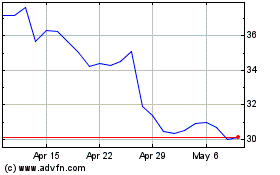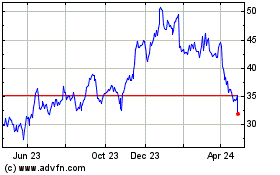Intel Raises Third-Quarter Revenue Expectations
September 16 2016 - 9:00AM
Business Wire
Intel Corporation today announced that third-quarter revenue is
expected to be above the company's previous outlook. The company
now expects third-quarter revenue to be $15.6 billion, plus or
minus $300 million, as compared to the previous range of $14.9
billion, plus or minus $500 million. The increase in revenue is
primarily driven by replenishment of PC supply chain inventory. The
company is also seeing some signs of improving PC demand.
The company is forecasting the mid-point of the third-quarter
GAAP gross margin range at 62 percent, plus or minus a couple of
points, up 2 points versus the prior third-quarter GAAP outlook
gross margin midpoint of 60 percent, driven mostly by higher PC
unit volume. The midpoint of the third-quarter non-GAAP gross
margin range is now forecasted at 63 percent, plus or minus a
couple of points, up 1 point versus the prior third-quarter
non-GAAP outlook gross margin midpoint of 62 percent.
Third-quarter R&D plus MG&A spending is expected to be
approximately $5.2 billion, $100 million higher than the prior
expectation of approximately $5.1 billion. Third-quarter gains and
losses from equity investments and interest and other income are
expected to be a net loss of approximately $125 million, as
compared to the prior expectation of a net loss of approximately
$75 million. The tax rate for the third quarter is expected to be
22 percent, as compared to the prior expectation of 21 percent.
All other expectations have been withdrawn and guidance will be
updated with the company's third-quarter earnings report on Oct.
18.
Business Outlook
Intel’s Business Outlook for the third quarter 2016 was
originally published in the company’s second quarter 2016 earnings
release, available at www.intc.com.
Intel’s updated Business Outlook does not include the potential
impact of any business combinations, asset acquisitions,
divestitures, strategic investments and other significant
transactions that may be completed after Sept. 16. Intel’s updated
Business Outlook is posted on intc.com and may be reiterated in
public or private meetings with investors and others through the
close of business on Sept. 16. Intel’s Quiet Period will start from
the close of business on Sept. 16 until publication of the
company’s third-quarter earnings release, scheduled for Oct. 18.
During the Quiet Period, all of the Business Outlook and other
forward-looking statements disclosed in the company’s news releases
and filings with the SEC should be considered as historical,
speaking as of prior to the Quiet Period only and not subject to an
update by the company.
Forward-Looking
Statements
The above statements and any others in this release that refer
to future plans and expectations are forward-looking statements
that involve a number of risks and uncertainties. Words such as
"anticipates," "expects," "intends," "goals," "plans," "believes,"
"seeks," "estimates," "continues," "may," "will," "should," and
variations of such words and similar expressions are intended to
identify such forward-looking statements. Statements that refer to
or are based on projections, uncertain events or assumptions also
identify forward-looking statements. Many factors could affect
Intel's actual results, and variances from Intel's current
expectations regarding such factors could cause actual results to
differ materially from those expressed in these forward-looking
statements. Intel presently considers the following to be important
factors that could cause actual results to differ materially from
the company's expectations.
- Demand for Intel's products is highly
variable and could differ from expectations due to factors
including changes in business and economic conditions; consumer
confidence or income levels; the introduction, availability and
market acceptance of Intel's products, products used together with
Intel products and competitors' products; competitive and pricing
pressures, including actions taken by competitors; supply
constraints and other disruptions affecting customers; changes in
customer order patterns including order cancellations; and changes
in the level of inventory at customers.
- Intel's gross margin percentage could
vary significantly from expectations based on capacity utilization;
variations in inventory valuation, including variations related to
the timing of qualifying products for sale; changes in revenue
levels; segment product mix; the timing and execution of the
manufacturing ramp and associated costs; excess or obsolete
inventory; changes in unit costs; defects or disruptions in the
supply of materials or resources; and product manufacturing
quality/yields. Variations in gross margin may also be caused by
the timing of Intel product introductions and related expenses,
including marketing expenses, and Intel's ability to respond
quickly to technological developments and to introduce new products
or incorporate new features into existing products, which may
result in restructuring and asset impairment charges.
- Intel's results could be affected by
adverse economic, social, political and physical/infrastructure
conditions in countries where Intel, its customers or its suppliers
operate, including military conflict and other security risks,
natural disasters, infrastructure disruptions, health concerns,
fluctuations in currency exchange rates, and the United Kingdom
referendum to withdraw from the European Union. Results may also be
affected by the formal or informal imposition by countries of new
or revised export and/or import and doing-business regulations,
which could be changed without prior notice.
- Intel operates in highly competitive
industries and its operations have high costs that are either fixed
or difficult to reduce in the short term.
- The amount, timing and execution of
Intel's stock repurchase program could be affected by changes in
Intel's priorities for the use of cash, such as operational
spending, capital spending, acquisitions, and as a result of
changes to Intel's cash flows or changes in tax laws.
- Intel's expected tax rate is based on
current tax law and current expected income and may be affected by
the jurisdictions in which profits are determined to be earned and
taxed; changes in the estimates of credits, benefits and
deductions; the resolution of issues arising from tax audits with
various tax authorities, including payment of interest and
penalties; and the ability to realize deferred tax assets.
- Gains or losses from equity securities
and interest and other could vary from expectations depending on
gains or losses on the sale, exchange, change in the fair value or
impairments of debt and equity investments, interest rates, cash
balances, and changes in fair value of derivative instruments.
- Product defects or errata (deviations
from published specifications) may adversely impact our expenses,
revenues and reputation.
- Intel's results could be affected by
litigation or regulatory matters involving intellectual property,
stockholder, consumer, antitrust, disclosure and other issues. An
unfavorable ruling could include monetary damages or an injunction
prohibiting Intel from manufacturing or selling one or more
products, precluding particular business practices, impacting
Intel's ability to design its products, or requiring other remedies
such as compulsory licensing of intellectual property.
- Intel's results may be affected by the
timing of closing of acquisitions, divestitures and other
significant transactions. In addition, risks associated with our
proposed transaction with TPG to collaborate to establish McAfee as
an independent cybersecurity company are described in the “Forward
Looking Statements” section of Intel’s press release dated Sept. 7,
2016, which risk factors are incorporated by reference herein.
- Intel’s results may be affected by
factors that could cause the implementation of, and expected
results from, the restructuring plan announced on April 19, 2016,
to differ from Intel’s expectations. A detailed description of
risks associated with the restructuring plan and factors that could
cause actual results of the restructuring plan to differ is set
forth in the “Forward Looking Statements” section of Intel’s press
release entitled “Intel Announces Restructuring Initiative to
Accelerate Transformation” dated April 19, 2016, which risk factors
are incorporated by reference herein.
A detailed discussion of these and other factors that could
affect Intel's results is included in Intel's SEC filings,
including the company's most recent reports on Forms 10-K and
10-Q.
About Intel
Intel (NASDAQ: INTC) expands the boundaries of technology to
make the most amazing experiences possible. Information about Intel
can be found at newsroom.intel.com and intel.com.
Intel, the Intel logo, Core, and Ultrabook are trademarks of
Intel Corporation or its subsidiaries in the United States and
other countries.
**Other names and brands may be claimed as the property of
others.
View source
version on businesswire.com: http://www.businesswire.com/news/home/20160916005404/en/
Intel CorporationTrey Campbell, 503-696-0431Investor
Relationstrey.s.campbell@intel.comorCara Walker,
503-696-0831Media Relationscara.walker@intel.com
Intel (NASDAQ:INTC)
Historical Stock Chart
From Mar 2024 to Apr 2024

Intel (NASDAQ:INTC)
Historical Stock Chart
From Apr 2023 to Apr 2024
